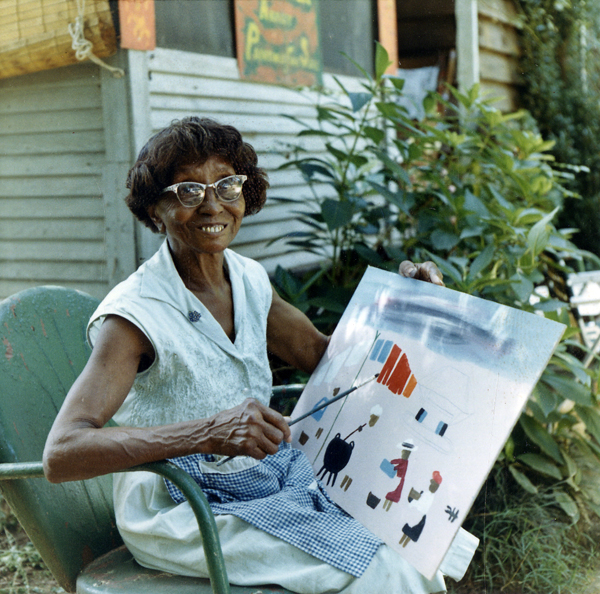Louisiana’s most famous female artist, Clementine Hunter, didn’t start creating art until around the age of 50. Born just a few decades after the Civil War, Hunter lived most of her life on the Hidden Hill and Melrose cotton plantations where she worked as a field laborer and domestic worker, respectively. It wasn’t until the mid-1940s when a visitor of the plantation left behind art supplies that Hunter began to create the art she is known for today.
Clementine Hunter; image courtesy of 64 Parishes.
Clementine Hunter became a self-taught folk artist. Her style employs bright colors and ignores perspective and scale. Most of her paintings involve scenes of daily life, religion, or plantation scenes, all made from memory. After finding those art supplies, Hunter created art nearly every day up until her death at the age of 101. Experts believe she painted anywhere between 5,000 and 10,000 paintings in her lifetime. Our client remembers meeting Hunter when he was a child. He told us “she was a very humble person, down to earth, and liked to talk about her art.”
Detail exhibiting Hunter’s unique style.
In the early stages of her artistic career, Hunter’s paintings would sell locally between 25 cents and a dollar each. Later, she would become “the first African-American artist to have a solo exhibition at what is now the New Orleans Museum of Art. But because of Jim Crow laws of the era she couldn’t attend” (Smithsonian.com). Hunter gained success as an artist and exhibited her works in New York City and Los Angeles during her lifetime, though she never wanted to travel outside of Louisiana to see them. Today, Hunter is widely known, and even has the largest collection by a single artist at the Smithsonian’s National Museum of African American History and Culture.
Before Treatment
Before Treatment
We recently had the privilege of treating one of Hunter’s pieces here at The Center. The work, titled “Pecan Pickin,’” is a small piece of plantation pottery with painted scenes of field laborers harvesting pecans. The figures are large, one is as tall as the tree he stands next to, and all are in profile. The colors are bright, and the brushstrokes are thick. Since Hunter typically painted on flat surfaces, this piece is particularly unique.
During treatment, before inpainting.
During treatment, before inpainting.
Our client, who purchased “Pecan Pickin’” at an estate auction in Louisiana, told us that the piece had shattered during shipment to his home. He brought the piece to The Center in many large fragments, all of which were retained. However, small scattered areas of loss were identified in and around the fragments. After the treatment proposal was approved and initial photography was completed, our Objects Department began their work.
During-treatment detail of the interior of the piece.
The broken pieces were fit together like a puzzle and were secured using a conservation-grade adhesive. Since there were some minor losses around the fractures, our conservators added a fill composed of conservation materials. These fills were contoured and colored to emulate the surrounding areas. Finally, this unique piece of plantation pottery was restored.
After Treatment
After Treatment (detail)
After Treatment
After Treatment
Our client is very happy with the treatment. “Pecan Pickin’” has a prominent spot in his home, among other works he owns by Hunter. “Out of all her pieces I have,” he says, “this one is my favorite.”
After Treatment













